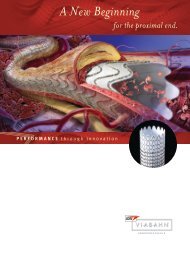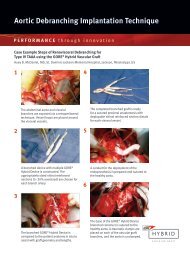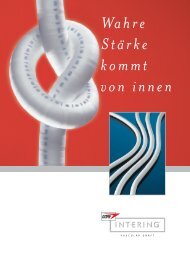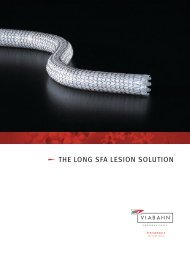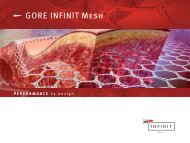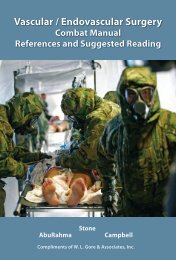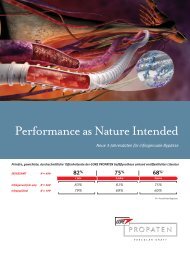Ten years of experience with the heparin-bonded - Gore Medical
Ten years of experience with the heparin-bonded - Gore Medical
Ten years of experience with the heparin-bonded - Gore Medical
Create successful ePaper yourself
Turn your PDF publications into a flip-book with our unique Google optimized e-Paper software.
<strong>Ten</strong> Years <strong>of</strong> Experience <strong>with</strong> <strong>the</strong> Heparin-Bonded ePTFE Grafttotally occluded coronary arteries: rationale, trial design and baselinepatient characteristics. Total Occlusion Study <strong>of</strong> Canada (TOSCA)Investigators. Can J Cardiol. 1998;14:825–832.11. Heyligers JM, Verhagen HJ, Rotmans JI, et al. Heparin immobilizationreduces thrombogenicity <strong>of</strong> small-caliber expanded polytetrafluoroethylenegrafts. J Vasc Surg. 2006;43:587–591.12. Begovac PC, Thomson RC, Fisher JL, Hughson A, Gällhagen A. Improvementsin GORE-TEX Vasculsr Graft performance by Carmeda BioActive Surface<strong>heparin</strong> immobilization. Eur J Vasc Endovasc Surg. 2003;25:432–437.13. Lin PH, Bush RL, Yao Q, Lumsden AB, Chen C. Evaluation <strong>of</strong> platelet depositionand neointimal hyperplasia <strong>of</strong> <strong>heparin</strong>-coated small-caliber ePTFEgrafts in a canine femoral artery bypass model. J Surg Res. 2004;118:45–50.14. Lin PH, Bush RL, Yao Q, Lumsden AB, Hanson SR. Small-caliber<strong>heparin</strong>-coated ePTFEgrafts reduce platelet deposition and neointimalhyperplasia in a baboon model. J Vasc Surg. 2004;39:1322–1328.15. Walluscheck KP, Bierkandt S, Brandt M, Cremer J. Infrainguinal ePTFEvascular graft <strong>with</strong> bioactive surface <strong>heparin</strong> bonding: first clinicalresults. J Cardiovasc Surg (Torino). 2005;46:425–430.16. Battaglia G, Tringale R, Monaca V. Retrospective comparison <strong>of</strong> a <strong>heparin</strong><strong>bonded</strong> ePTFE graft ans saphenous vein for infragenicular bypass: implicationsfor standard treatment protocol. J Cardiovasc Surg (Torino). 2006;47:41–47.17. Dorigo W, Pulli R, Alessi Innocenti A, et al. Lower limb below-kneerevascularization <strong>with</strong> a new bioactive pros<strong>the</strong>tic graft. A case-controlstudy. Ital J Endovasc Surg. 2005;12:75–81.18. Dorucci V, Griselli F, Petralia G, et al. Heparin-<strong>bonded</strong> expanded polytetrafluoroethylenegrafts for infragenicular bypass in patients <strong>with</strong> critical limbischemia: 2 year results. J Cardiovasc Surg. 2008;49(2):145–149.19. Dorigo W, Di Carlo F, Troisi N, et al. Lower limb revascularization <strong>with</strong> anew bioactive pros<strong>the</strong>tic graft: early and late results. Annals <strong>of</strong> VascularSurgery. 2008;22(1):79–87.20. Bosiers M, Deloose K, Verbist J, et al. Two-year results <strong>with</strong> <strong>heparin</strong>-<strong>bonded</strong>PTFE (<strong>Gore</strong> Propaten) grafts for femoropopliteal and femorodistalbypasses are encouraging. Abstract presented at: 32nd Annual VeithSymposium; November 17–20, 2005; New York, NY.21. Peeters P, Verbist J, delouse K, Bosiers M. Will <strong>heparin</strong>-<strong>bonded</strong> PTFE replaceautologius venous conduits in infrapoliteal bypass? J Vasc Endovasc Surg.2008;15:143–148.22. Hugl B, Nevelsteen A, Daenens K, et al.; PEPE II Study Group. PEPE II— A multicenter study <strong>with</strong> an end-point <strong>heparin</strong>-<strong>bonded</strong> expandedpolytetrafluoroethylene vascular graft for above and below knee bypasssurgery: Determinants <strong>of</strong> patency. J Cardiovasc Surg. 2009;50:195–203.23. Daenens K, Schepers S, Fourneau I, Houtho<strong>of</strong>d S, Nevelsteen A.Heparin-<strong>bonded</strong> ePTFE grafts compared <strong>with</strong> vein grafts infemoropopliteal and femorocrural bypasses: 1- and 2- year results. J VascSurg. 2009;49:1210–1216.24. Lösel-Sadée H, Alefelder C. Heparin-<strong>bonded</strong> expanded polytetrafluoroethylenegraft for infragenicular bypass: five-year results. J CardiovascSurg. 2009;50:339–343.25. Pulli R, Dorigo W, Castelli P, et al., on behalf <strong>of</strong> <strong>the</strong> Propaten ItalianRegistry Group. Midterm results from a multicenter registry on <strong>the</strong> treatment<strong>of</strong> infrainguinal critical limb ischemia using a <strong>heparin</strong>-<strong>bonded</strong>ePTFE graft. J Vasc Surg. 2010;1167–1177.Supplement to VDM September/October 2010 11
<strong>Ten</strong> Years <strong>of</strong> Experience <strong>with</strong> <strong>the</strong> Heparin-Bonded ePTFE Graft1.01.00.80.8Secondary Patency0.60.4Limb Salvage0.60.40.20.20.00.00 6 12 18 24 30 36 42 48Figure 2: Kaplan-Meyer curve for estimated 48-monthsecondary patency.Associates, Inc., Flagstaff, Arizona) was implanted in 425patients undergoing lower limb revascularization for criticallimb ischemia in seven Italian hospitals.The choice to use this device was made on <strong>the</strong> basis <strong>of</strong> <strong>the</strong> surgeons’discretion and not only in <strong>the</strong> absence <strong>of</strong> a suitable vein.Data concerning <strong>the</strong>se interventions were retrospectively collectedin a multicenter registry <strong>with</strong> a dedicated database includingmain preoperative, intraoperative and follow-up variables.Patient Group Pr<strong>of</strong>ilePatients were predominantly males (338 patients, 79%), <strong>with</strong>a mean age <strong>of</strong> 73.5 <strong>years</strong> (standard deviation [SD] 8.9 <strong>years</strong>).The indication for surgical intervention was <strong>the</strong> presence <strong>of</strong>critical limb ischemia in all patients (Ru<strong>the</strong>rford class 4 in 230patients, 54%; class 5 in 143 patients, 34%; and class 6 in <strong>the</strong>remaining 52, 12%).Interventions were performed for occlusion <strong>of</strong> a native vesselin 315 cases, while 110 patients had a reintervention for <strong>the</strong>late occlusion <strong>of</strong> a prior open or endovascular femoro-poplitealintervention. In 186 cases (44%), 1 patent tibial vessel waspresent. The remaining 239 patients (56%) had 2 or 3 patenttibial vessels. Mean preoperative ankle-brachial index in <strong>the</strong>affected limb was 0.35 (SD 0.18).Intervention PlanIntervention consisted <strong>of</strong> a below-knee bypass in 324patients (76%) and <strong>of</strong> an above-knee revascularization in <strong>the</strong>0 6 12 18 24 30 36 42 48Figure 3: Kaplan-Meyer curve for estimated 48-monthlimb salvage.remaining 101. In patients <strong>with</strong> below-knee bypass, distal targetvessels were <strong>the</strong> popliteal artery in 238 cases, <strong>the</strong> tibioperonealtrunk in 38 cases and a tibial vessel in <strong>the</strong> remaining 48cases (anterior tibial artery in 20 cases, posterior tibial artery in23 cases and peroneal artery in 5).All <strong>the</strong> patients received intraoperative administration <strong>of</strong>30–70 IU/Kg <strong>of</strong> intravenous <strong>heparin</strong> at arterial clamping on<strong>the</strong> basis <strong>of</strong> <strong>the</strong> surgeons’ preferences and habits.Postoperative and long-term medical treatment consisted <strong>of</strong>single antiplatelet <strong>the</strong>rapy in 221 cases, double antiplatelet <strong>the</strong>rapyin 43 cases and oral anticoagulants in 161 patients.Procedure OutcomesThere were 13 perioperative deaths, <strong>with</strong> a mortality rate <strong>of</strong>3%. The cause <strong>of</strong> death was cardiac in 10 patients, while <strong>the</strong>remaining 3 patients suffered from a fatal pulmonary embolism,an ischemic stroke and sepsis, respectively. One instance <strong>of</strong> perioperativesevere bleeding (requiring surgical revision at <strong>the</strong> distalanastomosis) occurred.Early graft thrombosis occurred in 32 patients, <strong>with</strong> a cumulative30-day graft patency rate <strong>of</strong> 92.5%. There were 18 early majoramputations, <strong>with</strong> a 30-day major amputation rate <strong>of</strong> 4.2%.Univariate analysis demonstrated that re-do surgery, a poor run<strong>of</strong>fscore and <strong>the</strong> need for adjunctive distal procedures significantlyaffected early graft thrombosis, while only re-do surgery andpoor run-<strong>of</strong>f score increased perioperative amputation rates.Multivariate analysis confirmed that reintervention and poor run-Supplement to VDM September/October 2010 13
<strong>Ten</strong> Years <strong>of</strong> Experience <strong>with</strong> <strong>the</strong> Heparin-Bonded ePTFE Graft<strong>of</strong>f score were independently associated <strong>with</strong> a higher risk <strong>of</strong> graftfailure (p=0.01; 95% confidence interval [CI] 0.18–0.82;p=
<strong>Ten</strong> Years <strong>of</strong> Experience <strong>with</strong> <strong>the</strong> Heparin-Bonded ePTFE GraftCommon Femoral Artery toBelow-Knee Popliteal ArteryBypass <strong>with</strong> <strong>Gore</strong> PropatenPTFE Graft: Short-Term ResultsSyed M. Hussain, MD, Jennifer L. Ash MD, Atif Baqai MD, Nabeel R. Rana MDIntroductionPeripheral arterial disease (PAD) is increasing at an alarmingrate and affects approximately 1 in 20 Americans. The U.S.Census Bureau predicts that in 2030 — when all baby boomerswill be 65 and older — nearly 1 in 5 U.S. residents will be 65or older. This age group is projected to increase to 88.5 millionin 2050, more than doubling <strong>the</strong> 2008 figure <strong>of</strong> 38.7 million.Similarly, <strong>the</strong> 85-and-older population is expected to morethan triple from 5.4 million to 19 million between 2008 and2050. 1 Fur<strong>the</strong>rmore, <strong>the</strong>re is predicted to be an increase inperipheral vascular procedures to 1.6 million, <strong>of</strong> which 1.2 millionwill be operative in nature. 2Infrainguinal bypass is used to save limbs that might o<strong>the</strong>rwiserequire amputation, to treat ischemic rest pain or tissueloss and to improve walking distances in patients <strong>with</strong> severelife-limiting claudication. Contemporary practice has involvedusing syn<strong>the</strong>tic conduit only when autologous vein is not available.As <strong>the</strong> patient population ages and <strong>the</strong> incidence <strong>of</strong> PADincreases, <strong>the</strong> availability <strong>of</strong> autologous vein conduit is decreasing.Many patients have already undergone vein harvest forcoronary artery bypass grafting (CABG) or for a previouslower- or upper-extremity arterial bypass procedure. In addition,many vein conduits are not in adequate condition or <strong>of</strong>adequate size (at least 3 mm in diameter) for a bypass procedure.Historically, <strong>the</strong> results <strong>of</strong> syn<strong>the</strong>tic bypass grafts have beeninferior to <strong>the</strong> results demonstrated by autologous vein.Notably, however, most studies comparing <strong>the</strong>se two modalities<strong>of</strong> treatment are over 10 <strong>years</strong> old. Fur<strong>the</strong>rmore, none<strong>of</strong> <strong>the</strong>se studies have assessed quality-<strong>of</strong>-life data or length <strong>of</strong>stay in <strong>the</strong> hospital. Until recently, syn<strong>the</strong>tic bypass graftshave made little technological advancement. Given <strong>the</strong>se factors,one question remains: Is <strong>the</strong>re a syn<strong>the</strong>tic graft that providescomparable results to autologous vein in patency and limb salvage,and also decreases length <strong>of</strong> hospital stay and improves overallquality <strong>of</strong> life?Review <strong>of</strong> Relevant Information and LiteratureHistorically, autologous vein has been <strong>the</strong> preferred conduit,especially for below-knee bypass procedures. In our <strong>experience</strong>,however, alternative conduits are increasingly becoming anecessity. As our patient population ages, we <strong>of</strong>ten see individualswho have no vein due to prior vein harvests, or have onlysuboptimal vein. Suboptimal vein (measuring
<strong>Ten</strong> Years <strong>of</strong> Experience <strong>with</strong> <strong>the</strong> Heparin-Bonded ePTFE GraftFigure 2. Oblique 3D view <strong>of</strong> <strong>the</strong> model during systole.Streamwise-vertical and spanwise-vertical planes showcontours <strong>of</strong> velocity. Vectors are black in <strong>the</strong> streamwiseverticalplane and white in <strong>the</strong> o<strong>the</strong>r planes. These vectorsshow <strong>the</strong> pointwise fluid velocity and direction.Figure 3. Conventional end-to-side ePTFE anastomosis —systolic acceleration. Flow travels straight through anastomosis.Heel has stagnant flow. Separation occurs at toeand secondary flow fills in <strong>the</strong> flow 2–3 vessel diametersdistally.and secondary flow fills in <strong>the</strong> flow 2–3 vessel diametersdistally.near <strong>the</strong> heel remained small <strong>with</strong> a correspondingly smallvortex. However, flow separation did occur in <strong>the</strong> hood to agreater degree than <strong>with</strong> <strong>the</strong> straight configuration.The flow separation at <strong>the</strong> toe increased as <strong>the</strong> secondaryflow weakened <strong>with</strong> deceleration. Although <strong>the</strong> angle <strong>of</strong>impingement was similar to <strong>the</strong> pre-cuffed geometry, <strong>the</strong>flow patterns <strong>with</strong> <strong>the</strong> DVP anastomotic geometry approximated<strong>the</strong> straight end-to-side configuration.DiscussionMagnetic resonance velocimetry has been previously used toproduce velocity measurements in a complex three-dimensionaldomain. 10 Analysis <strong>of</strong> velocimetry data produces velocity vectors,streamlines, and isosurfaces that visualize hemodynamicpatterns using pulsatile flow in anastomoses <strong>of</strong> varying geometry.We applied this technique to study <strong>the</strong> flow patterns in <strong>the</strong>anastomoses currently used in vascular surgical practice.MR velocimetry involves a three dimensional, quantitativeassessment <strong>of</strong> hemodynamic factors thought importantto <strong>the</strong> success <strong>of</strong> lower extremity bypass. Prior models todefine anastomotic hemodynamics have been two dimensional,qualitative models <strong>with</strong> idealized geometries. Theseprior models have relied on optically clear, rigid componentsthat result in a two-dimensional particulate analysis <strong>of</strong>flow patterns in noncompliant tubes. This study used actualbypass graft material in a non-rigid system resulting in flowrates and pressure waveforms that mimic physiologic, pulsatileflow conditions. Hemodynamic differences <strong>with</strong> varyinganastomotic geometries were captured in three dimensionsusing this technique. Areas <strong>of</strong> flow separation, recirculation,and vortex formation were evident during streamlinevisualization. Additionally, flow vectors indicated velocityand direction at points in <strong>the</strong> anastomotic site.Attempts have been made to elucidate <strong>the</strong> relationshipbetween hemodynamics and graft function. Norberto used acanine model to study <strong>the</strong> hemodynamics <strong>of</strong> cuffed graftsand found that graft compliance did not play a prominentrole in <strong>the</strong> reduction <strong>of</strong> <strong>the</strong> hyperplastic response <strong>of</strong>tenresponsible for graft failure. 11 Archie performed a fluiddynamics analysis using computational models <strong>of</strong> distal anastomoticsites <strong>with</strong> and <strong>with</strong>out a vein cuff. 12 The presence <strong>of</strong>a vein cuff reduced <strong>the</strong> potentially detrimental changes innear wall residence time and shear stress by shifting hemodynamicabnormalities to interface between <strong>the</strong> ePTFE and<strong>the</strong> vein cuff. Ojha measured wall shear using a photochromic tracer method. 13 These in vitro experiments implicateda number <strong>of</strong> potential hemodynamic stimuli for intimalhyperplasia including mean wall shear stress (WSS), wallshear rate (WSR), spatial wall-shear stress gradients (WSSG),and temporal wall-shear stress gradients. 14Ku et al proposed an oscillatory shear index (OSI) whichmeasures <strong>the</strong> tendency for shear stress to reverse from itsmean direction as an important parameter in optimal hemodynamics.15 The effect <strong>of</strong> mean wall-shear stress was studiedby How using near-wall velocity vector measurements todetermine wall shear stress. In this work, <strong>the</strong> addition <strong>of</strong> avein cuff led to a decreased area <strong>of</strong> low shear stress in <strong>the</strong>recipient artery <strong>of</strong> <strong>the</strong> anastomosis. 1620 Supplement to VDM September/October 2010
<strong>Ten</strong> Years <strong>of</strong> Experience <strong>with</strong> <strong>the</strong> Heparin-Bonded ePTFE GraftFigure 4. Precuffed ePTFE anastomosis — systolic acceleration.Due to large area <strong>of</strong> <strong>the</strong> cuff, <strong>the</strong> flow slows downbefore accelerating back into <strong>the</strong> native vessel. Heel hasslow flow. Toe region has high velocity and complex flowsince it is fed by secondary flow circulating from <strong>the</strong>impingement zone on <strong>the</strong> floor, up <strong>the</strong> vessel sides, andinto <strong>the</strong> toe region.Figure 5. Distal vein patch anastomosis — systolic acceleration.Flow turns as it enters <strong>the</strong> anastomosis creating a45° impingement angle. This creates an impingement linealong <strong>the</strong> vessel floor and strong secondary flows shownby streamlines that hit <strong>the</strong> floor, turn upward, and curve into<strong>the</strong> toe separation region.Keynton examined <strong>the</strong> effect <strong>of</strong> wall shear stress in acanine carotid model. The authors identified levels <strong>of</strong> wallshear (1500 1/s) above which <strong>the</strong>re was no hyperplasia andlevels below which over 92% <strong>of</strong> <strong>the</strong> hyperplasia occurred(350 1/s). 17 Loth studied hyperplasia in a canine ili<strong>of</strong>emoralPTFE bypass model. 18 Hyperplasia formed on <strong>the</strong> graft hoodand along <strong>the</strong> suture line especially in <strong>the</strong> anastomotic sinusat <strong>the</strong> heel. These areas correlate <strong>with</strong> <strong>the</strong> flow separationnoted in <strong>the</strong> MRV analysis. Loth proposed that flow fluctuationin <strong>the</strong> graft hood was proliferative due to flow separationwhile <strong>the</strong> flow fluctuations on <strong>the</strong> recipient vessel floorat <strong>the</strong> toe were less harmful due to variability in <strong>the</strong> stagnationpoint.Longest and Kleinstreuer performed a computationalstudy <strong>with</strong> a model for biological stimulation <strong>of</strong> hyperplasia.19 The model was based on near-wall residence time <strong>of</strong>blood, platelet activation, and surface reactivity and was ableto predict hyperplasia formation in agreement <strong>with</strong> in vivoobservations. Calculations for both pre-cuffed and straightconfigurations showed regions conducive to hyperplasia in<strong>the</strong> toe, graft hood, and <strong>the</strong> anastomotic heel. In <strong>the</strong> precuffedanastomosis, this resulted in a large area in <strong>the</strong> heel<strong>with</strong> slow flow, recirculation and high NWRT. This wasnoted to a lesser degree in o<strong>the</strong>r regions <strong>of</strong> <strong>the</strong> pre-cuffedanastomosis. These computational findings coincide <strong>with</strong> <strong>the</strong>MRV images in <strong>the</strong> current study.The MRV images and streamlines in this study indicate that<strong>the</strong>re are different velocity and flow pattern produced by anastomoses<strong>of</strong> varying geometry. The conventional end-to-sideconfiguration results in a small vortex at <strong>the</strong> anastomotic heel,decreased flow separation in <strong>the</strong> graft hood, and decreased flowseparation at <strong>the</strong> toe. Minimal secondary flows at <strong>the</strong> toe <strong>of</strong> <strong>the</strong>conventional anastomosis result in decreased surface reactivityand less time for particle-wall interaction.The pre-cuffed ePTFE graft creates flow patterns <strong>with</strong>increased flow separation in <strong>the</strong> hood <strong>of</strong> <strong>the</strong> graft and at <strong>the</strong>toe <strong>of</strong> <strong>the</strong> anastomosis, especially during <strong>the</strong> diastolic phase<strong>of</strong> <strong>the</strong> pulsatile cycle. The pre-cuffed configuration creates alarge vortex at <strong>the</strong> anastomotic heel <strong>with</strong> chaotic velocityvectors. Velocity vectors in <strong>the</strong> heel vortex demonstrate lowvelocity and disordered flow patterns.These areas <strong>of</strong> increased flow separation and vortex formationwould seem to be disadvantageous and correlate<strong>with</strong> noted areas <strong>of</strong> intimal hyperplasia formation. 16 Therewas no evidence <strong>of</strong> <strong>the</strong> high-velocity uniform flow thatwould maintain an advantageous high-shear stress environment.The distal vein patch anastomosis demonstrated flowseparation and vortices <strong>with</strong> magnitude between those in<strong>the</strong> straight and precuffed configurations. The distal veinpatch geometry resulted in a small vortex at <strong>the</strong> heel. Thispattern was closer to <strong>the</strong> straight graft hemodynamic patternas opposed to <strong>the</strong> precuffed geometry.ConclusionMagnetic resonance velocimetry produces three dimensionalvelocity measurements <strong>with</strong> sufficient accuracy andresolution to quantitatively analyze hemodynamics in anastomoticgeometries. The velocity vector fields and calculatedstreamlines demonstrate <strong>the</strong> effects <strong>of</strong> anastomotic geometryon hemodynamics. Flows generated by different graftSupplement to VDM September/October 2010 21
<strong>Ten</strong> Years <strong>of</strong> Experience <strong>with</strong> <strong>the</strong> Heparin-Bonded ePTFE Graftconfigurations were captured <strong>with</strong> marked differences notedbetween standard and pre-cuffed anastomotic geometries.The findings support a conventional end to side anastomosis<strong>with</strong> a low incidence angle using a straight graft as producingfavorable hemodynamics as compared to a cuffedconfiguration. The distal vein patch configuration approximates<strong>the</strong> conventional, straight anastomotic pattern. ThisMR technology has an imaging capability to study aspects<strong>of</strong> graft hemodynamics in vitro <strong>with</strong> possible in vivo applicationsin <strong>the</strong> future.NoteFigures originally pubished in Neville RF, Elkins CJ, Alley M, Wicker RB.Hemodynamic comparison <strong>of</strong> differing anastomotic geometries using magneticresonance velocimetry. J Surg Research January 1, 2010 [epub ahead <strong>of</strong> print].References1. Brewster DC. Composite grafts. In: Ru<strong>the</strong>rford RB, ed. VascularSurgery. Philadelphia: WB Saunders; 1989:481–486.2. Miller JH, Foreman RK, Ferguson L, Faris A. Interposition vein cufffor anastomosis <strong>of</strong> pros<strong>the</strong>ses to small artery. Aust NZ J Surg1984;54:283–285.3. Tyrell MR, Wolfe JN. New pros<strong>the</strong>tic venous collar anastomotic technique:combining <strong>the</strong> best <strong>of</strong> o<strong>the</strong>r procedures. Br J Surg1991;78:1016–1017.4. Taylor RS, Loh A, McFarland RJ, et al. Improved technique for polytetrafluoroethylenebypass grafting: Long-term results using anastomoticvein patches. Br J Surg 1992;79:348–354.5. Neville RF, Tempesta B, Sidawy AN. Tibial bypass for limb salvageusing polytetrafluoroethylene <strong>with</strong> a distal vein patch. J Vasc Surg2001;33:266–272.6. Neville RF, Elkins CJ, Alley M, Wicker RB. Hemodynamic comparison<strong>of</strong> differing anastomotic geometries using magnetic resonancevelocimetry. J Surg Research January 1, 2010 [epub ahead <strong>of</strong> print].7. Markl M, Chan FP, Alley MT, et al. Time-resolved three-dimensionalphase-contrast MRI. J Magn Reson Imaging 2003;17:499–506.8. Neville RF, Attinger C, Sidawy AN. Pros<strong>the</strong>tic bypass <strong>with</strong> a distalvein patch for limb salvage. Am J Surg 1997;174:173–176.9. Kissin M, Kansal N, Pappas PJ, et al. J Vasc Surg 2000;31(1 Pt 1):69–83.10. Markle M, Chan FP, Alley MY, et al. Time resolved three-dimensionalphase contrast MRI (4D-flow). J Magnetic Resonance Imaging2003;17:499–506.11. Norberto JJ, Sidawy AN, Trad KS, et al. The protective effect <strong>of</strong> veincuff anastomoses is not mechanical in origin. J Vasc Surg1995;21:558–566.12. Longest PW, Kleinstreuer, Archie JP. Particle hemodynamics analysis<strong>of</strong> Miller cuff arterial anastomosis. J Vasc Surg 2003;38:1353–1362.13. Ojha M. Wall shear stress temporal gradient and anastomotic intimalhyperplasia. Circulation Research 1994;74:1227–1231.14. Ojha M, Cobbold RS, et al. Influence <strong>of</strong> angle on wall shear stress distributionfor an end-to-side anastomosis. J Vasc Surg1994;19:1067–1073.15. Ku DN, Giddens DP, et al. Pulsatile flow and a<strong>the</strong>rosclerosis in <strong>the</strong>human carotid bifurcation. Positive correlation between plaque locationand low oscillating shear stress. Arteriosclerosis 1985;5(3):293–302.16. How TV, Rowe CS, Gilling-Smith G, et al. Interposition vein cuffanastomosis alters wall shear stress distribution in <strong>the</strong> recipient artery.J Vasc Surg 2000;31:1008–1017.17. Keynton RS, Evancho MM, Sims RL, et al. Intimal hyperplasia andwall shear in arterial bypass graft distal anastomoses: An in vivo modelstudy. J Biomechanical Engineering 2001;123(5):464–473.18. Loth FS, Jones A, Zarins CK, et al. Relative contribution <strong>of</strong> wall shearstress and injury in experimental intimal thickening at PTFE end-tosidearterial anastomoses. J Biomechanical Engineering 2002;124(1):44–51.19. Longest PC, Kleinstreuer, Deanda A. Numerical simulation <strong>of</strong> wallshear stress and particle-based hemodynamic parameters in pre-cuffedand streamlined end-to-side anastomoses. Annals <strong>of</strong> BiomedicalEngineering 2005;33(12):1752–1766.22 Supplement to VDM September/October 2010
<strong>Ten</strong> Years <strong>of</strong> Experience <strong>with</strong> <strong>the</strong> Heparin-Bonded ePTFE GraftNonhealing Ulcer <strong>of</strong> <strong>the</strong> Toeand Use <strong>of</strong> Heparin-BondedGraft in TreatmentEdward Y. Woo, MDIntroductionHistorically, below-knee popliteal and infrageniculate pros<strong>the</strong>ticbypasses have been met <strong>with</strong> very poor patency results.This case report examines <strong>the</strong> use <strong>of</strong> a novel <strong>heparin</strong>-<strong>bonded</strong>graft in <strong>the</strong> treatment <strong>of</strong> a nonhealing ulcer <strong>of</strong> <strong>the</strong> toe.Case ReportA 79-year-old female presented <strong>with</strong> a non-healing ulcer <strong>of</strong>her right second toe. This condition had been ongoing forapproximately 6 weeks, <strong>with</strong> no signs <strong>of</strong> healing. Her past medicalhistory was significant for coronary artery disease, diabetesmellitus, hypercholesterolemia, hypertension and peripheralvascular disease. She had a past surgical history including coronaryartery bypass grafting and multiple podiatric procedures.Her ulcer was managed by a podiatrist for over a month, butno progress had been made.A work-up was instituted. Ankle-brachial indices were 0.12on <strong>the</strong> right and 0.45 on <strong>the</strong> left. An angiogram demonstrateda complete occlusion <strong>of</strong> her superficial femoral artery andpopliteal artery. The peroneal artery had segmental occlusions,and <strong>the</strong> posterior tibial artery was completely occluded. Ananterior tibial artery did reconstitute in <strong>the</strong> mid-calf andformed a dorsalis pedis artery. Given <strong>the</strong> long-segment occlusions<strong>of</strong> <strong>the</strong> superficial femoral and popliteal as well as severeinfrageniculate disease, endovascular options were ruled out.Vein mapping was performed as shown in Figure 1.The patient was taken to <strong>the</strong> operating room. Her greatersaphenous, lesser saphenous, and cephalic veins were explored.However, all veins were small and sclerotic and unsuitable foruse as conduits. As a result, <strong>the</strong> decision was made to use <strong>the</strong><strong>Gore</strong> Propaten <strong>heparin</strong>-<strong>bonded</strong> PTFE graft as a conduit. Afemoro-anterior-tibial bypass was performed. From a technicalFigure 1. Vein mapping <strong>of</strong> 79-year-old female subject.Figure 2. Patency at 1 year as demonstrated bygraft duplex.From: <strong>the</strong> Hospital <strong>of</strong> <strong>the</strong> University <strong>of</strong> Pennsylvania University <strong>of</strong> Pennsylvania Health System.Address for Correspondence: Edward Y. Woo, MD; Vascular Laboratory/Division <strong>of</strong> Vascular Surgery and EndovascularTherapy; 4 Silverstein Pavilion; Hospital <strong>of</strong> <strong>the</strong> University <strong>of</strong> Pennsylvania, University <strong>of</strong> Pennsylvania Health System;3400 Spruce Street; Philadelphia, PA 19104. E-mail: edward.woo@uphs.upenn.edu.Supplement to VDM September/October 2010 23
<strong>Ten</strong> Years <strong>of</strong> Experience <strong>with</strong> <strong>the</strong> Heparin-Bonded ePTFE Graft100%Primary Patency for Below-Knee andInfropopliteal Bypass% Free from Loss <strong>of</strong> Patency80%60%40%20%0%GORE PROPATEN Vascular Graft0 3 6 9 12 16 18Time Post Treatment (months)Figure 4. Primary patency <strong>of</strong> below-knee popliteal andinfrapopliteal bypasses.Figure 3. A CT angiogram at 1 year showed a widelypatent graft, anastomoses and target vessel.standpoint, we always make an oblique incision in <strong>the</strong> groin forexposure <strong>of</strong> <strong>the</strong> femoral artery. This allows for better healing.A counter-incision is made over <strong>the</strong> anterior compartmentto expose <strong>the</strong> anterior tibial artery. The pros<strong>the</strong>tic graftis <strong>the</strong>n tunneled subfascial from <strong>the</strong> groin to <strong>the</strong> anteriortibial artery. This ensures that <strong>the</strong> graft stays deep throughoutits course and does not take a subcutaneous route. It alsoallows for closure <strong>of</strong> a muscle layer over <strong>the</strong> graft in <strong>the</strong> calf.Although it was not needed in this case, a sartorius muscleflap can be used for groin coverage. These extra layers arehelpful in preventing infection, especially when <strong>the</strong>re iswound breakdown.This patient did well postoperatively and was dischargedhome uneventfully. Her ulcer healed in a few weeks. Graft surveillancewas performed at 1 month and <strong>the</strong>n at 6-monthintervals. At <strong>the</strong> 1-year mark, a graft Duplex demonstrated apatent graft (Figure 2). However, <strong>the</strong> target vessel appeared tohave a stenosis and a CT angiogram was performed (Figure 3).This demonstrated a widely patent graft, anastomoses and <strong>the</strong>target vessel. It has now been more than 2 <strong>years</strong> since <strong>the</strong>patient had <strong>the</strong> operation, and <strong>the</strong> graft remains widely patent<strong>with</strong> no interventions.DiscussionThis case highlights <strong>the</strong> <strong>Gore</strong> Propaten <strong>heparin</strong>-<strong>bonded</strong>graft, which has demonstrated markedly better results whencompared to historical controls. At our institution we have performedmore than 68 implants in various positions, <strong>with</strong> anoverall patency rate <strong>of</strong> 94% at 30 days and 86% at 18 months.Fur<strong>the</strong>rmore, we have performed 29 bypasses below <strong>the</strong> knee(popliteal/infrageniculate). The patency for this group at 30days was 90% and at 18 months 76% (Figure 4). Because <strong>of</strong><strong>the</strong>se improved results, we now use <strong>the</strong> Propaten graft in anyposition and any time we use a pros<strong>the</strong>tic PTFE graft.24 Supplement to VDM September/October 2010
<strong>Ten</strong> Years <strong>of</strong> Experience <strong>with</strong> <strong>the</strong> Heparin-Bonded ePTFE GraftInfra-Inguinal Arterial Bypass WithPropaten: How I Do ItNiren Angle, MD, RVT, FACSAbstractThe advent <strong>of</strong> endovascular <strong>the</strong>rapy has spurred a revolutionin lower-extremity revascularization for claudication orcritical-limb ischemia over <strong>the</strong> last decade. Althoughendovascular treatment for lower-extremity arterial diseasehas advanced tremendously, bypass surgery as a whole continuesto exhibit longer durability than endovascular interventions.Despite <strong>the</strong> better patency rates <strong>of</strong> bypass surgery,<strong>the</strong> procedure’s morbidity — especially morbidity <strong>with</strong>wound-healing — limits enthusiasm on <strong>the</strong> part <strong>of</strong> somepractitioners. Overall, however, vein remains <strong>the</strong> superiorconduit for lower-extremity bypass surgery, particularlyinfrapopliteal bypass.Heparin-<strong>bonded</strong> ePTFE (<strong>Gore</strong> Propaten Vascular Graft,W.L. <strong>Gore</strong> & Associates, Flagstaff, Arizona) is a novel syn<strong>the</strong>ticconduit wherein <strong>heparin</strong> molecules are end-point covalently<strong>bonded</strong> to <strong>the</strong> ePTFE and, <strong>the</strong>refore, do not get eluted<strong>of</strong>f <strong>with</strong> pulsatile blood flow. Literature would suggest thatPropaten has better 1- to 2-year primary patency than historicallyhas been <strong>the</strong> case for lower-extremity pros<strong>the</strong>ticbypasses. 1 The objective <strong>of</strong> this article is to describe my technicalmethod <strong>of</strong> performing lower-extremity bypass <strong>with</strong> <strong>the</strong>ePTFE graft.Patient SelectionFor an above-knee femoropopliteal bypass, I preferPropaten over saphenous vein, as <strong>the</strong> patency rates are comparable.The ideal situation for <strong>the</strong> use <strong>of</strong> Propaten, in myopinion, is for an infrapopliteal bypass wherein <strong>the</strong>re is notadequate vein, and <strong>the</strong> lesion falls into <strong>the</strong> TASC C or Dcategory. Assuming a primary endovascular approach isunsuccessful, a bypass <strong>with</strong> Propaten is <strong>the</strong>n an option.TechniqueThe operation can be performed under general anes<strong>the</strong>siaor continuous spinal/epidural anes<strong>the</strong>tic. The epidural can<strong>the</strong>n be maintained for <strong>the</strong> initial 48 to 72 hours for paincontrol. However, in my <strong>experience</strong>, a properly done PTFEbypass usually lets physicians discharge most patients <strong>with</strong>in72 hours — and some, particularly patients <strong>with</strong> above-kneefemoro-popliteal bypass, <strong>with</strong>in 24 to 48 hours.With ei<strong>the</strong>r method, <strong>the</strong> patient is administered preoperativeantibiotics, <strong>the</strong>n <strong>the</strong> lower extremity is prepped anddraped from <strong>the</strong> umbilicus down to <strong>the</strong> foot. I use Ioban(3M, St. Paul, Minnesota) for draping <strong>of</strong> <strong>the</strong> surgical site,particularly <strong>with</strong> pros<strong>the</strong>tic graft material.The common femoral artery is exposed through a 3- to 4-inch incision from <strong>the</strong> inguinal ligament down to <strong>the</strong> groincrease . This is carried through <strong>the</strong> skin and subcutaneous tissueusing electrosurgery, and <strong>the</strong> femoral sheath is <strong>the</strong>n opened.The extent <strong>of</strong> exposure <strong>of</strong> <strong>the</strong> common femoral arterydepends on <strong>the</strong> degree <strong>of</strong> disease at <strong>the</strong> femoral bifurcation.If <strong>the</strong>re is significant pr<strong>of</strong>unda femoris disease, than <strong>the</strong> arterialexposure needs to be more extensive than if <strong>the</strong> pr<strong>of</strong>undais disease-free. The common femoral artery, <strong>the</strong> superficialfemoral artery (SFA), and <strong>the</strong> pr<strong>of</strong>unda are also encircled<strong>with</strong> Silastic vessel loops.Above-Knee Popliteal Artery BypassFor an above-knee popliteal artery exposure, an incision ismade on <strong>the</strong> medial aspect <strong>of</strong> <strong>the</strong> thigh above <strong>the</strong> knee(Figure 1). To facilitate this exposure, a cotton roll is placedunder <strong>the</strong> calf, and <strong>the</strong> knee is partially flexed. An incision ismade on <strong>the</strong> medial aspect <strong>of</strong> <strong>the</strong> thigh below <strong>the</strong> vastusmedialis and carried down through <strong>the</strong> muscle fascia.The sartorius muscle is reflected inferiorly and dissectionis carried out past <strong>the</strong> fatty tissue close to <strong>the</strong> posterioraspect <strong>of</strong> <strong>the</strong> femur. The adductor tendon is <strong>the</strong>n appreciatedas <strong>the</strong> popliteal artery exits Hunter’s canal. The poplitealartery is <strong>the</strong>n exposed for a length <strong>of</strong> approximately 5 to 6From: The University <strong>of</strong> California, San Diego Health Sciences.Address for correspondence: Niren Angle, MD, RVT, FACS, UCSD <strong>Medical</strong> Center — Hillcrest, 200 West Arbor Drive,San Diego, CA 92103. E-mail: nangleka@gmail.com.Supplement to VDM September/October 2010 25
<strong>Ten</strong> Years <strong>of</strong> Experience <strong>with</strong> <strong>the</strong> Heparin-Bonded ePTFE Graftcm and encircled <strong>with</strong> Silastic loops. It is very important touse monopolar electrosurgery as little as possible when dissectingaround <strong>the</strong> popliteal artery because <strong>the</strong> saphenousnerve travels intimately <strong>with</strong> <strong>the</strong> artery; injury or transection<strong>of</strong> <strong>the</strong> saphenous nerve or <strong>of</strong> <strong>the</strong> sartorial or anterior branchcan result in anes<strong>the</strong>sia <strong>of</strong> <strong>the</strong> anterior leg.The patient is <strong>the</strong>n given 100 units/kg <strong>of</strong> <strong>heparin</strong> intravenouslyand, simultaneously, a <strong>Gore</strong> tunneler is used to tunnela 6 mm Propaten (non-ringed) graft from <strong>the</strong> groin to<strong>the</strong> above knee popliteal fossa in a subsartorial tunnel. Thetunnel is created by blunting clearing space on <strong>the</strong> anterioraspect <strong>of</strong> <strong>the</strong> SFA into <strong>the</strong> popliteal fossa. The Propaten graftis <strong>the</strong>n tunneled through <strong>with</strong> <strong>the</strong> sheath <strong>of</strong> <strong>the</strong> tunneler.The common femoral artery is <strong>the</strong>n clamped <strong>with</strong> anangled DeBakey clamp, as proximal as necessary, as it exitsunder <strong>the</strong> inguinal ligament. The SFA is <strong>the</strong>n clamped <strong>with</strong>an angled DeBakey clamp and a pr<strong>of</strong>unda clamp is used toocclude <strong>the</strong> pr<strong>of</strong>unda femoris artery.An 11 blade is used to create an arteriotomy and isextended <strong>with</strong> a Potts scissors. If <strong>the</strong>re is a significant plaquethat is amenable to an endarterectomy, <strong>the</strong>n an endarterectomyis performed. The graft is <strong>the</strong>n cut and shaped appropriately<strong>with</strong> a tonsil clamp to match <strong>the</strong> arteriotomy. It isimportant to emphasize that <strong>the</strong> geometry <strong>of</strong> <strong>the</strong> graft anastomosismust be such that <strong>the</strong> graft takes a lazy course as itoriginates from <strong>the</strong> artery. This requires that <strong>the</strong> angle <strong>of</strong> <strong>the</strong>cut on <strong>the</strong> graft be less than 45 degrees.Once <strong>the</strong> anastomosis is completed — but not yet tieddown — <strong>the</strong> last three suture loops are loosened <strong>with</strong> a finenerve hook. The artery is flushed antegrade and retrograde, butonly once <strong>the</strong> graft is clamped <strong>with</strong> a Fogarty shodded clamp.The lumen is flushed <strong>with</strong> <strong>heparin</strong>ized saline, and <strong>the</strong> distalclamp on <strong>the</strong> pr<strong>of</strong>unda is released to fill <strong>the</strong> lumen <strong>with</strong> blood.Under <strong>the</strong> continuous retrograde bleeding, which distends <strong>the</strong>lumen, <strong>the</strong> suture line is tied down. The proximal clamp is<strong>the</strong>n released to restore flow through <strong>the</strong> native system.The popliteal artery is <strong>the</strong>n clamped in a similar manner.I tend to prefer using Yasargil clips for occluding <strong>the</strong>popliteal artery. If <strong>the</strong> SFA is occluded, one option is to performan end-to-end anastomosis. Alternatively, <strong>the</strong> mostcommonly done anastomosis is an end-to-side anastomosis(Figure 2). My preference is to perform an end-to-end spatulatedanastomosis in all cases due to <strong>the</strong> more favorablehemodynamics <strong>of</strong> such a procedure. The concern aboutcompromising retrograde flow is largely <strong>the</strong>oretical.I perform <strong>the</strong> anastomosis <strong>with</strong> a running 6-0 Prolenesuture and once again, after <strong>the</strong> native artery is flushed antegradeand retrograde, under continuous retrograde bleeding,<strong>the</strong> suture line is tied down. Flow is <strong>the</strong>n restored in <strong>the</strong>Figure 1. For an above-knee popliteal artery exposure, anincision is made on <strong>the</strong> medial aspect <strong>of</strong> <strong>the</strong> thigh above<strong>the</strong> knee.Figure 2. If <strong>the</strong> SFA is occluded, one option is to performan end-to-end anastomosis. Alternatively, <strong>the</strong> most commonlydone anastomosis is an end-to-side anastomosis.native popliteal artery. The <strong>heparin</strong> is routinely reversed<strong>with</strong> protamine sulfate. Once hemostasis is ensured, <strong>the</strong> incisionis closed <strong>with</strong> layers <strong>of</strong> 3-0 Vicryl for <strong>the</strong> subcutaneoustissues and 4-0 Monocryl for <strong>the</strong> skin.Below-Knee Popliteal Artery BypassThe proximal exposure for <strong>the</strong> femoral artery is done <strong>the</strong>same way as described above. The below-knee poplitealartery is exposed in <strong>the</strong> standard fashion <strong>with</strong> an incisionbelow <strong>the</strong> knee on <strong>the</strong> medial aspect <strong>of</strong> <strong>the</strong> leg. The skin andmuscle fascia are opened using electrosurgery, and <strong>the</strong> medialhead <strong>of</strong> <strong>the</strong> gastrocnemius is retracted posteriorly bluntly.The popliteal fossa is entered and <strong>the</strong> popliteal vein isretracted to expose <strong>the</strong> artery. The popliteal artery is flankedby paired veins that are virtually fused to <strong>the</strong> artery. Theartery must be separated from <strong>the</strong> flanking veins sharply and<strong>the</strong> artery encircled <strong>with</strong> vessel loops. The graft is <strong>the</strong>n tunneledin <strong>the</strong> manner described above and <strong>the</strong> arterial anastomosisperformed <strong>with</strong> a running 6-0 Prolene suture.Tibial Artery BypassFor purposes <strong>of</strong> conciseness, <strong>the</strong> technique <strong>of</strong> intividualtibial artery exposure will not be described here. Once <strong>the</strong>26 Supplement to VDM September/October 2010
<strong>Ten</strong> Years <strong>of</strong> Experience <strong>with</strong> <strong>the</strong> Heparin-Bonded ePTFE Graftartery in question is exposed based on <strong>the</strong> pre-operative arteriogram,<strong>the</strong> proximal anastomosis is performed as previouslydescribed.If <strong>the</strong> tibial artery is very s<strong>of</strong>t, clamping <strong>with</strong> Yasargil clips isa decent option. Each tibial artery has venae commitantes thatare very fragile; dissecting <strong>the</strong>se veins can be treacherous.Bleeding from <strong>the</strong>se veins is very troublesome and usuallyresults in ligation <strong>of</strong> <strong>the</strong> veins <strong>the</strong>mselves. For this reason andalso for calcified tibial arteries, I prefer to use a tourniquet forinflow occlusion. Cracking <strong>the</strong> plaque on <strong>the</strong>se tibial arteriescan be very risky and can compromise <strong>the</strong> outflow artery.After <strong>the</strong> proximal anastomosis is done, <strong>the</strong> tourniquet isplaced above <strong>the</strong> knee. An Esmark bandage is used to exsanguinate<strong>the</strong> limb from <strong>the</strong> foot to <strong>the</strong> knee, <strong>the</strong>n <strong>the</strong> tourniquetis inflated to roughly twice <strong>the</strong> patient’s systolic blood pressure.I open <strong>the</strong> tibial artery <strong>with</strong> an 11 blade that is used toserially score <strong>the</strong> arterial wall until <strong>the</strong> lumen is entered. ADiettrich-Potts scissors is <strong>the</strong>n used to extend <strong>the</strong> arteriotomy.The graft is <strong>the</strong>n cut and shaped to length; it should benoted that <strong>the</strong> arteriotomy should be at least 3 to 4 cm. Thegraft is <strong>the</strong>n pulled to length and sutured in an end-to-sideand fashioned <strong>with</strong> 7-0 Prolene.The native artery is <strong>the</strong>n forward and back-bled, <strong>the</strong> graftflushed and reclamped and <strong>the</strong> lumen flushed <strong>with</strong><strong>heparin</strong>ized saline. Under continuous retrograde bleedingfrom <strong>the</strong> artery, <strong>the</strong> suture line is tied down and flow is <strong>the</strong>nrestored into <strong>the</strong> native artery. Hemostasis is obtained and<strong>the</strong> incisions closed in <strong>the</strong> standard fashion.The tourniquet technique is <strong>the</strong> most atraumatic <strong>of</strong> techniquesfor arterial anastomosis; I recommend its use for anyinfrapopliteal bypass in diabetics and in non-diabetics.Occasionally one will encounter arteries that, despite <strong>the</strong>tourniquet, are impossible to occlude. In <strong>the</strong>se cases, one canuse intraluminal flowresters.ConclusionPros<strong>the</strong>tic bypass <strong>with</strong> Propaten appears to provide a reasonablealternative when suitable vein is not available andendovascular approaches have failed or are inadequate. Thegeometry <strong>of</strong> <strong>the</strong> anastomosis is critical for graft patency, andatraumatic, careful handling <strong>of</strong> <strong>the</strong> artery is critical for goodshort-term outcomes.I put <strong>the</strong> patients on 48 hours <strong>of</strong> low-dose, unfractionatedintravenous <strong>heparin</strong> for its anti-inflammatory properties, <strong>the</strong>nstop <strong>the</strong> <strong>heparin</strong>. I do not routinely place patients <strong>with</strong> pros<strong>the</strong>ticbypasses on warfarin. Aspirin plus clopidogrel is my regimen<strong>of</strong> choice for tibial bypasses, though admittedly <strong>with</strong>outsupporting data.If autogenous vein is available, this remains <strong>the</strong> gold standardfor arterial reconstruction. If <strong>the</strong> vein is <strong>of</strong> poor quality,is inadequate or absent, <strong>the</strong>n <strong>the</strong> use <strong>of</strong> Propaten forlower-extremity arterial reconstruction is a good alternative.Ringed grafts, in my opinion, are rarely necessary and forinfra-inguinal bypasses, <strong>the</strong> 6 mm diameter <strong>of</strong> <strong>the</strong> Propatengraft is <strong>the</strong> proper choice. For axillo-femoral or femor<strong>of</strong>emoralbypass, 8 mm grafts are more appropriate.The proper reconstruction <strong>of</strong> <strong>the</strong> arterial system must beconsidered in <strong>the</strong> context <strong>of</strong> <strong>the</strong> age <strong>of</strong> <strong>the</strong> patient, <strong>the</strong> functionalgoal <strong>of</strong> <strong>the</strong> operation, <strong>the</strong> options for conduit and <strong>the</strong>patient’s ability to undergo extensive rehabilitation. A comprehensiveassessment <strong>of</strong> <strong>the</strong> patient will help guide <strong>the</strong> mostappropriate <strong>the</strong>rapy <strong>of</strong> <strong>the</strong> patient <strong>with</strong> lower-extremity arterialdisease.Reference1. Pulli R, Dorigo W, Castelli P, et al; Propaten Italian Registry Group.Midterm results from a multicenter registry on <strong>the</strong> treatment <strong>of</strong>infrainguinal critical limb ischemia using a <strong>heparin</strong>-<strong>bonded</strong> ePTFEgraft. Journal <strong>of</strong> Vascular Surgery 2010;51:1167–1177.Supplement to VDM September/October 2010 27
Copyright 2010 ©TM, LLC83 General Warren Blvd., Suite 100Malvern, PA 19355www.hmpcommunications.com




